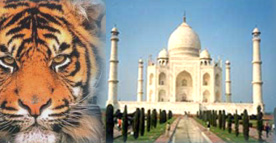|
The temples of Khajuraho are among the most magnificent temples of India. These temples were built by the rulers of the Chandela dynasty of central India between 9th and 10th century. The temples are famous all over the world for a large number of erotic sculptures, which are wonderful works of art, and also tell us a lot about the lifestyle of the people of ancient India. These temples are visited by numerous tourists from all parts of the globe, and are counted among the most important tourist attractions in Madhya Pradesh.
There are 25 temples still standing in the Khajuraho complex. It is said that originally 85 temples had been built, but they did not survive the ravages of time. Having remained hidden by a dense forest cover for almost seven centuries, these magnificent temples were rediscovered in the 19th century by a British officer, much like the Ajanta and Ellora caves. These temples were abandoned after the decline of the Chandela rulers in the 13th century. The remoteness of their location saved these temples from destruction by the invading Islamic forces that arrived in India in the 11th century.
The figures of Apsaras (celestial nymphs) dominate the temple sin Khajuraho. Showcasing the mastery of the artisans, particularly in depicting the female form, these have often been carved to act as support brackets. The temples are divided into three groups. These are �
The western group �
The major temples in this group are �
Kandariya Mahadev � this temple represents the pinnacle of north Indian temple arc. It is massive in proportions and features an amazing blend of complex design with a uniform harmony. The temple features over 800 sculptures that depict erotic scenes, Gods, war themes, dancers, musicians and scenes from the courtly ceremonies.
Lakshmana temple � this temple is similar to the Kandariya Mahadev temple, but it has many figures that are unique to it. The female bracket figures and the pair of street singers are notable among these.
The large statue of Varaha, Vishnu�s boar incarnation, is located in a pavilion opposite the temple. The temple dates back to the 10th century AD.
Vishwanath temple � dating to 11th century, this temple also features splendid sculptures, including the famous Apsara picking a thorn from her foot, and another Apsara playing the flute.
Matangeshwar temple � this temple is still used for daily worship. It was built around 900 AD.
The eastern Group �
The eastern group of temples includes �
Jain Parsvanath temple � this temple was built around 950 AD. It is known for the intricately carved ceiling pendants, and the sculptures of three Apsaras.
The Ghantai temple and Adinath temple are the other major temples in the eastern group.
The southern group �
The Southern Group represents the final stages of building in the complex. The Chaturbhuj temple is the most prominent temple in this group. Built in 1090 AD, this temple has a magnificent four armed statue of Lord Shiva in the inner sanctum. This temple does not have any erotic sculptures.
An archaeological museum near the entrance of the western group of temples exhibits an impressive collection of sculptures and other pieces of art found in the area. The exhibits include a frieze that shows the construction of the Khajuraho temples. The Khajuraho temples have been declared as a world heritage site by the UNESCO.
Learn more about the Khajuraho temples and tourism in Madhya Pradesh in touristplacesinindia.com.
Back to Seven Wonders of India
 |
|

